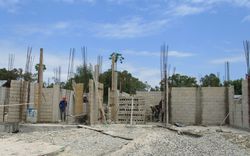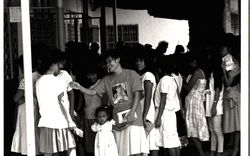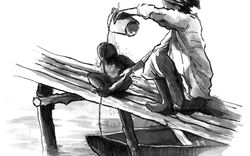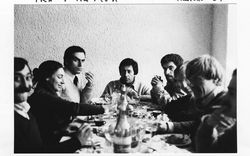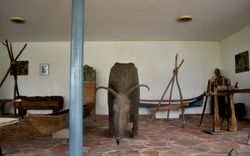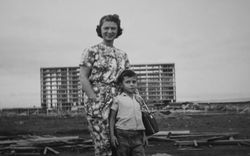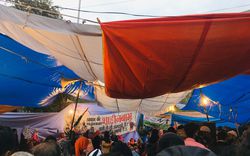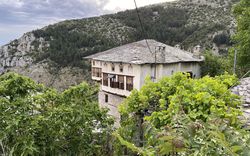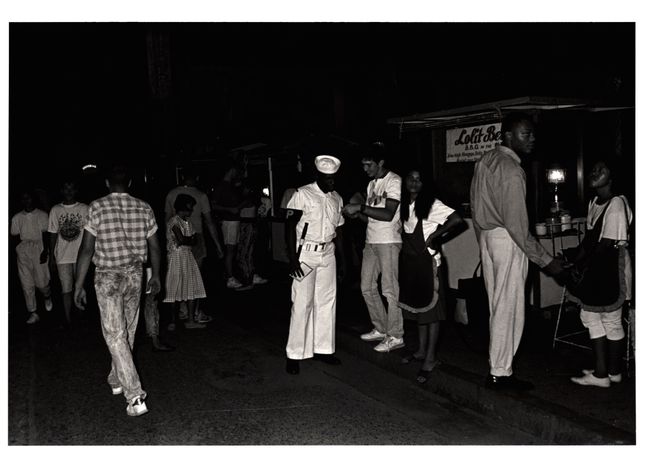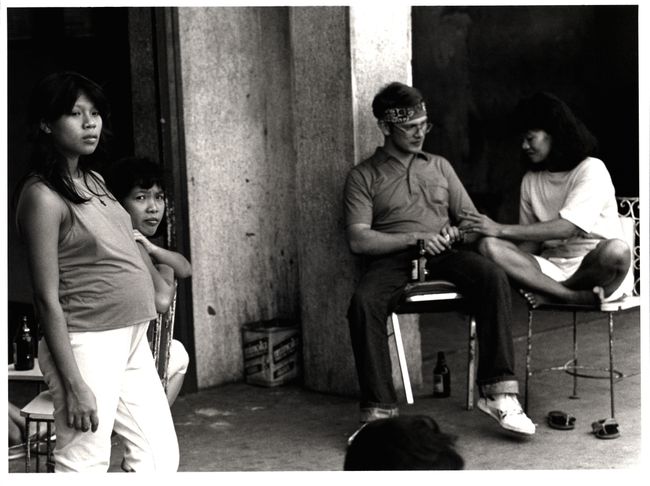Foreign Arms and the Economic Body
Will Davis examines the sexual economies of military space
One day in June in the town of Olongapo, children playing in the streets stopped and looked skyward. Women may have gasped as they leaned out of windows to get a better look, and navy servicemen sitting outside bars paused mid-conversation to stare, as a thick column of dark, billowing clouds silently climbed into the atmosphere from the peak of Mount Pinatubo. Days later, the volcanic eruption itself forced over a cubic mile of material twenty-two miles into the sky. The year was 1991, and the cataclysmic event forced the closure of two of the largest overseas United States military bases in the world. Ending almost a century of their operation, the eruption of Mount Pinatubo was the giant exclamation mark that terminated the Military Bases Agreement between the US and the Philippines. The volume of ash dumped on the bases quickly rendered billions of dollars of military equipment useless at Subic Bay Naval Base and Clark Airbase, and accelerated the withdrawal of troops from the islands after the Philippine Senate barred the renewal of their leases.
Subic and Clark were evacuated in the aftermath of Pinatubo’s eruption, each leaving behind an adjacent town, Olongapo and Angeles, and emptying out their economies. Scripted into the urban spaces of these towns was a distinct bio-political zone of regulated sex work for overseas US servicemen between 1947 and 1991. Smoky bars, sparsely furnished boarding houses, and a busy main strip were organized around a body economy of race and nation under the proviso of entertainment. “Rest and Recreation,” meaning down time spent between the call of duty, had become—and remains—a part of overseas military life. During the war in Vietnam, vast aircraft carriers, floating islands of military space, could unload up to ten thousand servicemen into Subic Bay daily. For the maintenance of US-Philippine foreign relations, sex and its management were key themes in the discourse around overseas servicemen, and R&R therefore became part of the larger framework of “trans-pacific security.” While the policing of sexuality was often portrayed as a necessary evil of military security, it had wide-ranging and pervasive effects on the countries in which it took place. This text seeks to elicit how sexual economies functioned in urban spaces at these base towns, and to examine an overlooked aspect of the military-settler complex as it relates to the body and latent colonial relationships.
After the bases were evacuated in 1991, some fifty-five thousand women were left jobless, with Pinatubo achieving in hours what anti-base activists had for years been campaigning for. Like the collapse of aircraft hangars under the weight of volcanic ash, the trans-pacific intimate economies were revealed as the fragile structures they really were. These military spaces, interconnected by aircraft carriers, Foucauldian heterotopias moving “from brothel to brothel,” formed part of a larger colonial framework and imperial legacy.1 The Military Bases Agreement, signed in 1947, was one of numerous treaties that tied the Philippines to the United States in the years following its independence from the latter in 1946, drawn up for the “collective defense … of peace and security … in the Pacific area.”2 While shrouded in pacts, ratifications, and military verbiage, the way in which the US military and its new host country spatialized these relationships on land for the defense of the ocean entailed a series of “contact zones,” states of sovereign exception at each port of call.3
A feminist architectural history of base town sex work calls into consideration the fact that women were not passive victims of a dichotomous arrangement. Rather, sex workers and entertainers were in control of the spaces they occupied. The bar, the street, and the hotel were scripted spaces for a “corponomy,” to use performance artist Eisa Jocson’s term, that capitalized on their fleeting visitors.4 Understanding how these spaces were gendered reveals contradictions: vice, shame, power, and pretense were aspects of R&R that can be understood through the base towns’ urban program, while women working there organized advocacy networks such as the Women’s Education, Development, Productivity and Research Organization (WEDPRO) that also encompassed clinics and survivor centres.5 Just as sexually transmitted infections were, for the military, less a moral problem than one of efficiency, so too were collective action networks and advocacy support groups established to respond to a biopolitical situation.6 As a powerful rubric for understanding the histories of global body economies, colonialism often scripts the political as a see-saw, leaving the subject on the ground or in the air. Just so, the female Philippine subject was often left suspended without agency amid the base town economy.
The strip, bar, casa, and clinic help to illuminate how this phenomenon functioned. Information on them has been gathered from two primary sources: the first is a 1990 report titled Women Entertainers in Angeles and Olongapo, and the second, published in 2001, is Halfway Through the Circle. Both were created by WEDPRO, and while the first is a report that details the organizational structure of base town sex work based on a survey conducted among 150 women in Olongapo, the second is a series of eight oral histories from survivors of sex trafficking.7 Additionally, three photographs captured in Olongapo by Saundra Sturdevant, a photographer and activist who documented base town prostitution from the perspectives of women during the 1980s and 1990s, supplement this text.8
-
Two extreme types of heterotopias, brothels, and colonies are discussed by Michel Foucault’s notes on the ship, a “heterotopia par-excellence,” that moves between them. Michel Foucault and Jay Miskowiec, “Of Other Spaces,” Diacritics 16, no. 1 (1986): 22–27. ↩
-
Military Bases Agreement, March 14, 1947. 1947, the year that followed the Philippines’ independence from the US, the High Commissioner Paul McNutt and President Manuel Roxas signed the Military Bases Agreement. It permitted the US to retain control of its twenty-three land and sea bases for a further ninety-nine years, on the understanding that it was “mutually beneficial” to both countries. ↩
-
Mary Louise Pratt uses the term “contact zone” to designate “social spaces where cultures meet, clash, and grapple with each other, often in contexts of highly asymmetrical relations of power, such as colonialism, slavery, or their aftermaths as they are lived out in many parts of the world today.” While Pratt uses the designation to describe friction in linguistic terms, it also does some conceptual work for understanding how base towns were biological and military contact zones. Mary Louise Pratt, “Arts of the Contact Zone,” Profession (1991): 34. And: Giorgio Agamben, State of Exception (Chicago: University of Chicago Press, 2005). ↩
-
Performance artist Eisa Jocson uses the term “corponomy” to describe the body economies of the Philippine female subject. Her performance lecture of the same title describes how the body “becomes an archive of performative labor techniques that unpacks identity and gender formation, seduction politics and Filipino social mobility.” “2017 Corponomy, A Performance Lecture,” Eisa Jocson (blog), May 7, 2018, https://eisajocson.wordpress.com/works/2017-corponomy-a-performance-lecture/. ↩
-
An alternative architectural history of prostitution is described by Diane Ghirardo in the town of Ferrara during the renaissance. Diane Yvonne Ghirardo, “The Topography of Prostitution in Renaissance Ferrara,” Journal of the Society of Architectural Historians 60, no. 4 (2001): 402–31. ↩
-
See also: Stephanie Fajardo, “Authorizing Illicit Intimacies: Filipina–GI Interracial Relations in the Postwar Philippines,” Philippine Studies: Historical and Ethnographic Viewpoints 65, no. 4 (November 29, 2017): 485–513. ↩
-
Virginia A Miralao, Celia O Carlos, and Aida F Santos, Women Entertainers in Angeles and Olongapo: A Survey Report (Quezon City, Philippines: Women’s Education, Development, Productivity, and Research Organization and Katipunan ng Kababaihan para sa Kalayaan, 1990).; Louie C Amilbangsa, Aida F Santos, Flor Caagusan, and Development Women’s Education Productivity and Research Organization (Philippines), Halfway through the circle: the lives of 8 Filipino survivors of prostitution & sex trafficking (Quezon City, Philippines: The Women’s Education, Development, Productivity and Research Organization (Wedpro), 2001): 163. ↩
-
I am grateful to Fabio Lanza and New Press publishers for permission to reproduce these images. Many thanks to Tim Noakes of Special Collections at Stanford University, where Sturdevant’s archives are held, for finding the images and coordinating under remote circumstances. The images are part of the collection published in Saundra Pollock Sturdevant and Brenda Stoltzfus, Let the Good Times Roll: Prostitution and the U.S. Military in Asia, New York: New Press : Distributed by Norton, 1993. ↩
A checkpoint marked the physical boundary of a serviceman’s passage between base town and base. The checkpoint, consisting of a gate manned by soldiers checking IDs, served as a first incidence of tabulation to keep track of the whereabouts of servicemen “on liberty” after leaving the jurisdiction of the base and entering that of the host country. Maps of the town and its bars were handed out to servicemen upon leaving the base. It would appear that the sense that servicemen were on a mission even during periods of R&R was a pervasive one, reconciling military life with the absence of actual combat. In Olongapo, after passing through the checkpoint they would follow Magsaysay Drive, the main strip which was lined with bars and clubs. Upon leaving the checkpoint, servicemen’s movements could be traced across their ID number, the number of an establishment, and its coordinating information in the map—a list of numbered bars and hotels transforming the strip into a navigable space of operations. In this sense, the first form of urbanism was a triangulation between soldier, map, and strip—perhaps the only glimpse servicemen would see of the host country—all of which the provost marshal (head of the military police) had oversight of. This system was a way for the military to coordinate with the clinic, and for the provost marshal to trace the provenance and circulation of STIs. Women that used the main strip as their stage for business were termed “streetwalkers,” and were afforded more flexibility by not being tied to a particular bar or hotel. However, because their trade occurred in the open, they ran the risk of prosecution, as the Navy required women to be registered to a particular establishment in order to have a semblance of control over STIs.1 Streetwalkers’ independence came with vulnerability: the conditions of street life meant more proximity to drugs and their pushers, violent pimps, and violent customers.
-
In the survey conducted by WEDPRO, the sample size was 150 women in Olongapo. The 125 registered women entertainers contacted at the Social Hygiene Clinic worked in massage parlors, bars, clubs along Magsaysay Drive (the strip). Another 25 were unregistered streetwalkers who were interviewed while they were temporarily detained at the Police Substation in Olongapo—they were in jail for having failed to produce ID cards as ‘registered entertainers’ in the city. Virginia A Miralao, Celia O Carlos, and Aida F Santos, Women Entertainers in Angeles and Olongapo: A Survey Report (Quezon City, Philippines: Women’s Education, Development, Productivity, and Research Organization and Katipunan ng Kababaihan para sa Kalayaan, 1990). ↩
While the base was organized according to US laws and urban design—a grid of streets with bungalows and American street names like Dewey Avenue and Betty Lane—its surroundings of Olongapo were administered as a hybrid of American and Philippine law. The chairman of Olongapo town council, school, and hospital boards was also the commanding officer of Subic Bay Naval Base, and any crimes involving servicemen were tried in US Navy courts. Just as servicemen’s movements were recorded at the checkpoint, women working the bars were kept track of using a registration system that, in addition to binding them to a particular establishment and their weekly checks at the clinic, made their movements trackable. Bar workers were restricted to the venue where they worked, and in order for a customer to spend any time with a woman who worked as a hostess or dancer outside of the bar, they had to pay a “bar fine.” The longer the time away from the bar, the higher the fine. In addition to the clubs’ strict policy with regard to women’s comings and goings, certain conditions within served to muddy the transactions that took place. According to WEDPRO’s 1990 report, eighty-six percent of women drank while at work, something considered a necessary part of the job for women who earned a commission on the number of drinks customers bought for them.1 Bars had various categories of women who worked in them: while some exclusively danced or worked the bar, others—so long as they were paid a “bar fine” by the customer—could come and go, likening the practice to what Rhacel Parreñas calls a form of “indentured mobility” in which some seemingly independent movement is a part of the condition of contract.2 Even though women who worked in the clubs might have had more protection than streetwalkers, protection was at the whim of the club manager, who decided how much commission to take or how much leniency to extend.
-
Miralao, Carlos, and Santos, Women Entertainers in Angeles and Olongapo, 44. ↩
-
Rhacel Parreñas, Servants of Globalization: Migration and Domestic Work, Second Edition, Stanford, CA: Stanford University Press, 2020. For example, hotels in Angeles City (outside Clark airbase) had a list of bar girls to contact when customers asked for it. Halfway Through the Circle, 163. ↩
The vast majority of hotels doubled as “casas” whose workers were “live-in.” As opposed to workers at the bar, they depended on the hotel as their accommodation as well as their income. Casa workers could not choose customers and did not have control over the number they served. The casa owner took the earnings, while the worker kept a percentage after her lodging was deducted. These women were limited to acquiring customers from a spatial threshold zone of portals, doors, balconies, and verandas. WEDPRO’s report emphasizes that while bar and club workers were attached to the club, they were supposedly protected from unruly customers. Casa workers were afforded no such protection; posing as hotel proprietors, casa owners would rarely take responsibility for violent customers that threatened or attacked women, operating instead in self-interest while running an illegal operation.
Limits on women’s movements were central to the organization of the casa. This meant that the space of the threshold became a part of the town’s gendering. In a context far removed geographically and temporally, Diane Ghirardo notes a similar spatial imperative at work, in which the “unexceptional architectural character of public and private brothels” in Renaissance Ferrara illustrated the contradictions at play. Sex work was a “private activity to be conducted under public scrutiny, and therefore not in other private settings, in a designated building indistinguishable from its neighbors.”1 Part of the scheme of sex work common to both contexts, then, involved a visual urban literacy in order to follow the rules of the trade.
-
Ghirardo, “The Topography of Prostitution in Renaissance Ferrara,” 424. ↩
Biological regulation of sexual conduct in the clinic stood as a counterpart and extension to the chemical regulations entailed by bar and casa work. Women registered at bars and clubs were required to have bi-weekly checkups at the Olongapo Social Hygiene Clinic, a joint US Navy and Olongapo City government operation, located in a barrio community at some distance from the base and strip. The clinic provided sexual health checkups, and the Navy provided drugs and other medical products. Though its operation was allegedly for the protection of the city’s women, the STI smear tests that women were required to undergo were intended to keep the Filipino women entertainers “clean” for their servicemen clientele, who in turn were not required to undergo the same checkups, despite being carriers or sources of disease.1 After an AIDS scare in Olongapo in 1987, all of the women working in bars were required to submit HIV and AIDS testing without explanation or orientation, nor were their results disclosed.2 The clinic therefore stood in contradistinction to the bio-chemical control of the bar and strip; while it was removed from the main theatre of activity, it was core to the US military’s concern with efficiency.
Such an arrangement can be understood through other transpacific examples. Lisa Lowe has identified a similar logic at play between the colonial British treatment of Chinese sex workers in Hong Kong in the late nineteenth century, where women were required to be registered to particular brothels, and those who serviced European clientele underwent mandatory inspections. This legislation, Lowe argues, provided for a classification of Chinese sex workers as “diseased,” which was a form of colonial knowledge production; “rather than a conquest of physical territory, it assembled through medical surveillance the information about the bodies of the colonized, thereby contributing to the colonial epistemology about the Chinese.”3 Efficiency, whereby biological and chemical oversight are part of the administration of a territory, was a technique of governance at Olongapo. The specificity of targeting health as a part of this structure is identified as a component of “settler militarism” by Juliet Nebolon, who uses the term to show how public health programs in Hawai’i during World War II were a “bio-political administration [that] strategically targeted health and hygiene.”4 Health, for Nebolon, was a matter of military surveillance, territorial organization, and population control, illustrating how wartime-style administration took place on the periphery of war itself across the Pacific. Olongapo, like Hawai’i, was organized under the suspension of ordinary laws (Hawai’i was under martial law during WWII) meaning that while sex work was illegal in the Philippines, it could be authorized through specific programs of protection, not of local women, but of military institutions and reputations.
-
Women Entertainers in Angeles and Olongapo, 3. ↩
-
Aida F. Santos and Cecilia T. Hofmann, with Alma Bulawan, “Prostitution and the Bases: A Continuing Saga of Exploitation,” Coalition Against Trafficking in Women—Asia Pacific (CATW-AP) (May 1998). ↩
-
Lisa Lowe, The Intimacies of Four Continents (Durham: Duke University Press, 2015), 126–127. ↩
-
Juliet Nebolon, “‘Life Given Straight from the Heart’: Settler Militarism, Biopolitics, and Public Health in Hawai’i during World War II,” American Quarterly 69, no. 1 (March 30, 2017): 24–25. ↩
Base town sex work was an issue of social and spatial justice. While patriarchy and poverty spawned the sex work that was prevalent at Olongapo, the bases institutionalized it.1 The condemnable use of women’s sexual services deserves attention as part of a history of military urbanisms, and as a feminist architectural history of military spaces. The examples here foreground the ways in which women’s work took different forms in a highly programmed space. The onstage and offstage intertwining in the strip, bar, casa, and clinic pose some of the contradictions inherent to the economy of militarized sexual relations, yet they do not represent fixed subject positions. Does the pervasiveness of base town smoky bars or sparsely furnished boarding houses render them insignificant? Or is their significance due in part to their gendered architectural program: dull, overlooked, and thus globally recognizable?
In 1993, a class-action lawsuit was filed by the Filipino women’s advocacy organization Gabriela. It sought a lump-sum payment from the US Navy of 8,000 USD per child for some 8 600 children allegedly abandoned by US military fathers, amounting to roughly 69 million USD. Cecilia Hofmann, the group’s spokeswoman, noted that the “lawsuit is the result of our frustrations … the navy regulated access to these bars. They required women to go to the health clinic. What this implies is that the Navy felt it was ok for their personnel to have sexual contact with these women.”2 The case, which was settled out of court, was led by case attorney Joe Cotchett, who described that “for more than fifty years the navy regulated the [sex work] traffic in Olongapo at Subic Bay. Now it’s time the navy lived up to its responsibility for these children.”3
-
In her introduction to the Angeles/Olongapo survey report, Aida Fulleros Santos writes that, “We have to constantly remind ourselves that this institutionalized use of women’s sexual services—oftentimes for a pittance—is a condemnable situation which deserves attention, as much as issues of national interest such as the presence of the US military bases. For if the bases are seen by a growing number of Filipinos as an encroachment of foreign powers upon national sovereignty, the question of institutionalized bases prostitution is a question of social justice and national dignity particularly of our women, our children, and collectively of our people.” Women Entertainers in Angeles and Olongapo, Foreword. ↩
-
“Class-Action Lawsuit Filed for Philippine Amerasian Children - UPI Archives,” March 4, 1993, https://web.archive.org/web/20170822193000/http://www.upi.com/Archives/1993/03/04/Class-action-lawsuit-filed-for-Philippine-Amerasian-children/3131731221200/. See also: William Branigin. “FILIPINO AMERASIANS SUE U.S. FOR $68 MILLION,” Washington Post, March 5, 1993, https://www.washingtonpost.com/archive/politics/1993/03/05/filipino-amerasians-sue-us-for-68-million/d7aa377b-9d70-407d-b77f-e0c01814cf49/. ↩
-
Joe Cotchett’s firm, Cotchett, Pitre & McCarthy, describe the case on their website: “Cotchett is involved in extensive pro bono work. In one such case, he brought a lawsuit against the United States Navy on behalf of 8,600 Amerasian children in the Philippines who were left in villages after the closing of the Subic Bay Naval Base. The case ended in a settlement giving direct U.S. aid to the children fathered by U.S. servicemen and a television documentary on the subject.” Joseph W. Cotchett, accessed February 22, 2020, https://www.cpmlegal.com/attorneys-Joseph-Cotchett-attorney.html. ↩


